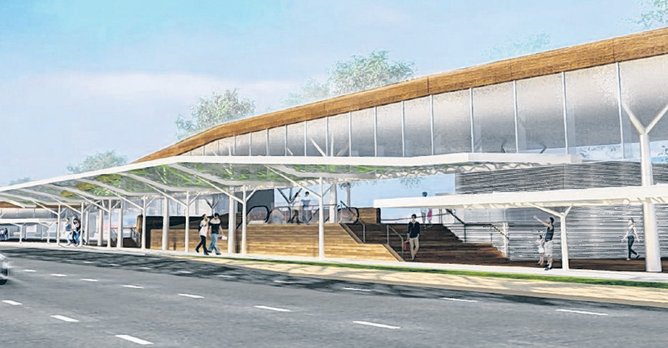Rising costs push bill for final stage of Circle Line to $4.85b
11 Apr 2019|3,796 views
The sixth and final stage of the Circle Line will cost $4.85 billion - more than half what the first five stages of the orbital MRT line cost. The 4km Circle Line 6 (CCL6), which will make the Circle Line a complete circle, will cost $1.2 billion per kilometre, or five times the average per-km cost of the first five stages spanning 33km.
The cost of the first five operating stages - at around $8 billion - covers an underground train depot in Kim Chuan, as well as additional expenses associated with a tunnel collapse at Nicoll Highway in 2004.
At $4.85 billion, the cost of the final stage also exceeds the $3.7 billion projected for it in 2015. Responding to queries from The Straits Times, the Land Transport Authority (LTA) attributed the cost escalation to various factors.
"First, construction of CCL6 is challenging," the LTA said, explaining that the line will run underneath "built-up downtown areas and the old Tanjong Pagar Railway Station building".
The challenge, it added, included integrating the new stretch to the first five stages, which are already in operation. Next, inflation. The authority pointed out that work on the first five stages of the Circle Line "started almost two decades ago, when price levels were lower". It added that the bill also included the cost of expanding the CCL Kim Chuan Depot, and the building of a multi-storey bus depot.
Lastly, the authority said operating systems on the existing Circle Line had to be upgraded to match that of CCL6. Could all six stages of the Circle Line have been built at one go, to save on inflationary cost?
Weighing in, National University of Singapore transport researcher Lee Der-Horng said, "It is kind of obvious that CCL6 is necessary for the further development of the Greater Southern Waterfront." He added that a complete circle is more beneficial to commuters, "just like the Yamanote Line... which connects the busiest and most important built-up areas in Tokyo".
Transport economist Walter Theseira of the Singapore University of Social Sciences said, "I suspect that the connection at the south is somewhat less economical to build in the first instance, especially since it doesn't add much to connectivity."
But Dr. Theseira noted that there has been "quite a shift in thinking" regarding how rail infrastructure is financed over the years. Previously, every line had to be deemed commercially viable on its own before it could be built.
Also, he said, a completely orbital line being able to provide better redundancy to the rail network "probably wasn't appreciated in the 1990s" when the Circle Line was planned. Construction of CCL6, which will have three stations in the Keppel area, has begun. It is slated to open in 2025.
The sixth and final stage of the Circle Line will cost $4.85 billion - more than half what the first five stages of the orbital MRT line cost. The 4km Circle Line 6 (CCL6), which will make the Circle Line a complete circle, will cost $1.2 billion per kilometre, or five times the average per-km cost of the first five stages spanning 33km.
The cost of the first five operating stages - at around $8 billion - covers an underground train depot in Kim Chuan, as well as additional expenses associated with a tunnel collapse at Nicoll Highway in 2004.
At $4.85 billion, the cost of the final stage also exceeds the $3.7 billion projected for it in 2015. Responding to queries from The Straits Times, the Land Transport Authority (LTA) attributed the cost escalation to various factors.
"First, construction of CCL6 is challenging," the LTA said, explaining that the line will run underneath "built-up downtown areas and the old Tanjong Pagar Railway Station building".
The challenge, it added, included integrating the new stretch to the first five stages, which are already in operation. Next, inflation. The authority pointed out that work on the first five stages of the Circle Line "started almost two decades ago, when price levels were lower". It added that the bill also included the cost of expanding the CCL Kim Chuan Depot, and the building of a multi-storey bus depot.
Lastly, the authority said operating systems on the existing Circle Line had to be upgraded to match that of CCL6. Could all six stages of the Circle Line have been built at one go, to save on inflationary cost?
Weighing in, National University of Singapore transport researcher Lee Der-Horng said, "It is kind of obvious that CCL6 is necessary for the further development of the Greater Southern Waterfront." He added that a complete circle is more beneficial to commuters, "just like the Yamanote Line... which connects the busiest and most important built-up areas in Tokyo".
Transport economist Walter Theseira of the Singapore University of Social Sciences said, "I suspect that the connection at the south is somewhat less economical to build in the first instance, especially since it doesn't add much to connectivity."
But Dr. Theseira noted that there has been "quite a shift in thinking" regarding how rail infrastructure is financed over the years. Previously, every line had to be deemed commercially viable on its own before it could be built.
Also, he said, a completely orbital line being able to provide better redundancy to the rail network "probably wasn't appreciated in the 1990s" when the Circle Line was planned. Construction of CCL6, which will have three stations in the Keppel area, has begun. It is slated to open in 2025.
Latest COE Prices
June 2025 | 1st BIDDING
NEXT TENDER: 18 Jun 2025
CAT A$96,999
CAT B$113,000
CAT C$62,000
CAT E$113,900
View Full Results Thank You For Your Subscription.





















